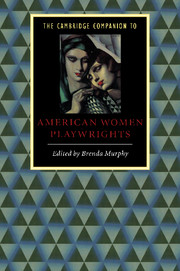10 - Feminist theory and contemporary drama
from Part 3 - New feminists
Published online by Cambridge University Press: 28 May 2006
Summary
What is a feminist drama? At first glance, this question suggests a binary split: a play is or is not feminist, depending on its rhetorical or didactic intention or, in other words, on its politics. But just as the feminist movement itself has, in this century, repeatedly emerged as a political movement and then seemingly disappeared, diffusing into the mainstream of American thought, so has feminism in American drama. Playwriting, performance, and dramatic theory today offer a feminist political critique through the act of dramatic speech, of costume and visual image, of performance itself. Just as feminists of the sixties and seventies discovered that “the personal is political,” so in the nineties, the political nature of all performance has emerged as a major theme.
In the twentieth century, drama that is feminist in intention has exhibited a commitment to telling the stories of silenced and marginalized women, celebrating women’s community and sense of connection through group protagonists, and expressing the moral concerns and societal criticisms that arise from women’s experience. The eighties and nineties have built on this tradition and added a broadened spectrum of political concerns, a questioning of language and of visual images and icons, and a specific concern with performance itself as an expression of gender and racial identity.
- Type
- Chapter
- Information
- The Cambridge Companion to American Women Playwrights , pp. 155 - 172Publisher: Cambridge University PressPrint publication year: 1999
- 2
- Cited by



